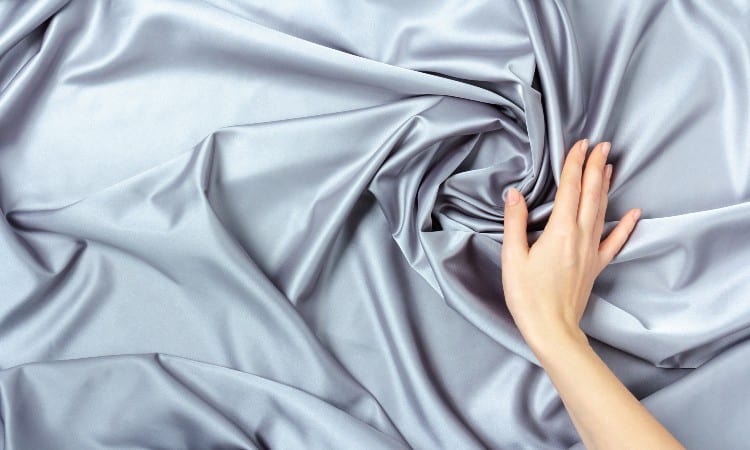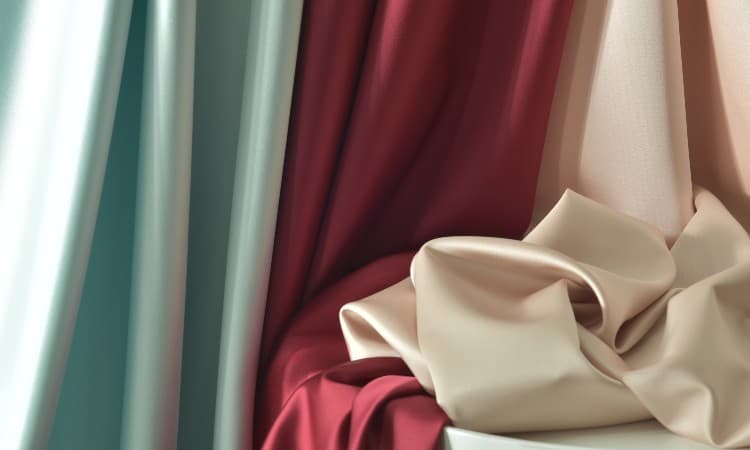Satin and sateen are fabrics with identical appearance, making it tricky to tell them apart. The question is, do you need to? Can they create the same items? When it comes to satin vs sateen, what is the difference?
The main difference between satin and sateen is the fiber content. Satin comes from filament fibers like silk, polyester, or nylon. Sateen is from staple fibers which form short spun yarns. The usual fiber in sateen is cotton. Both fabrics have the same weave pattern. But the cotton content of sateen makes it more durable than satin.
Both fabrics have a luxurious feel. But can they make the same things? Read on to discover which material is best when it comes to satin vs sateen.

Satin vs Sateen
Neither satin nor sateen are terms used to describe fabric. They are both names given to a specific type of weave. While most fabrics are woven so that one thread goes over or under another, sateen and satin have a 4:1 thread ratio.
This means that four threads go over or under one thread. One of the areas in which these two similar fabrics differ is the way the 4:1 ratio is woven.
The pattern of the 4:1 ratio differs between the two materials. For satin, the weave is a “one over four under” pattern, running horizontally across the fabric. Creating a warp-faced fabric with four weft threads going under one warp thread.
Sateen, on the other hand, is weft-faced. This means the weft threads go over the warp threads. The weave still runs horizontally across the width of the fabric. But, this time, four weft threads go over one warp thread.
It’s not always easy to scrutinize the weave in fabric to identify the difference between satin vs sateen. Especially when you’re standing in a shop trying to tell which is which. Counting threads through a magnifying glass is going to get you some funny looks.
To make your life easier, we’ve put a comparison table together to highlight the properties of both fabrics. We’ll take a more detailed look at each characteristic later in the article.
| Characteristic | Satin | Sateen |
|---|---|---|
| Allergies | Hypoallergenic Resistant to dust mites, mildew, and mold | Hypoallergenic Resistant to dust mites, mildew, and mold |
| Appearance | Luxurious | Lustrous sheen |
| Breathability | Breathable if silk-based | Breathable |
| Care | Not always machine washable Needs delicate care Dry clean or hand wash recommended | Easy to wash Not delicate No special treatment needed |
| Comfort | Lightweight Does not cause friction | Lightweight Does not cause friction |
| Cost | Determined by quality. Budget options are available | Determined by quality. Budget options are available |
| Durability | Luxurious rather than durable | Tough and durable |
| Fiber Content | Silk, Polyester, or Nylon | Cotton, Rayon, or Bamboo |
| Texture | Silky smooth | Smooth but not as silky |
| Warmth | Cool in hot climates Offers some warmth when cold | Warm in cold climates Can be cooling in hot weather |
What Is Satin?

Satin has a similar appearance to silk. With a shiny, luscious surface and a duller finish to the wrong side of the fabric, it’s a material that portrays luxury.
Historically, satin was produced from silk. Originating in China, the fabric quickly gained popularity across Europe in the 12th Century. Becoming a firm favorite with royalty, it was considered expensive and opulent.
Still linked to extravagance, modern-day satin can be made from silk, polyester, or nylon. These materials can be blended to make a satin fabric that benefits from the good points of all three fibers.
The various fiber and blend combinations can make the fabric look and feel different depending on the mix used. Silk-based satin will act and feel the same as silk. Polyester will give a shinier finish and won’t have the same breathability. This difference in fabric characteristics is why many people believe only the silk-based variation can be called satin.
| Pros | Cons |
|
|
Uses
 Satin can be used for several projects, from clothing to ballet shoes and upholstery to bedsheets. Some of the most popular forms of apparel include lingerie, ties, and dresses.
Satin pajamas and bedsheets are a firm favorite, particularly if the satin content is silk-based. The silky-smooth nature of the fabric makes garments and sheets light, airy and friction-free. All essential properties to prevent knotting or matting in hair while sleeping.
Satin can be used for several projects, from clothing to ballet shoes and upholstery to bedsheets. Some of the most popular forms of apparel include lingerie, ties, and dresses.
Satin pajamas and bedsheets are a firm favorite, particularly if the satin content is silk-based. The silky-smooth nature of the fabric makes garments and sheets light, airy and friction-free. All essential properties to prevent knotting or matting in hair while sleeping.
The luxurious feel and appearance of satin give an element of decadence to home décor and furnishings at a fraction of the price of silk.
How Is Satin Made?
Woven from silk or synthetic threads such as nylon and polyester, satin is made from filament fibers. These are fibers with an indefinite length running continuously in one long line.
A filament fiber doesn’t need to be spun to create longer lengths, unlike the staple short fibers such as cotton, jute, or wool.
Satin is woven in a 4:1 ratio of low-twist threads, creating a twill-like weave. It’s this weave that gives satin its smooth and silky appearance.
The actual combination of warp and weft threads can differ. Some weaves can be more of a 1:3:1 ratio with more or fewer weft threads being covered by one warp thread. The variations in the weave create different thread counts or thicknesses of satin fabric.
What Is Sateen?

Sateen is a soft and durable fabric with a similar look and feel to satin. The main difference between the two is sateen is made using staple short yarns like cotton, rayon, and sometimes bamboo.
As the basis for sateen is a plant-derived material, the resulting fabric has the durability and breathability of the natural fibers. The most popular fiber for use in sateen is cotton.
With a similar weave to satin, sateen is a soft fabric with a shiny top-side and dull reverse. It’s a weft-faced fabric meaning the weft threads are woven over the top of warp threads. The ratio is the same as in satin, 4:1, which means four weft threads over one warp thread.
Sateen’s cotton base gives the fabric more durability than silk-based satin. It’s also machine washable and resilient. Although it has the same luscious appearance, it’s not a delicate material like satin.
| Pros | Cons |
|
|
Uses
 Sateen can be used to create a whole range of projects. Originally popular in vintage apparel, the fabric is still a firm favorite for women’s clothing—particularly dresses, blouses, and suits.
Sateen can be used to create a whole range of projects. Originally popular in vintage apparel, the fabric is still a firm favorite for women’s clothing—particularly dresses, blouses, and suits.
Due to its inherent durability, sateen is a great fabric for curtains and home décor. The fabric is machine washable and can be tumble-dried, making it ideal for bedding and other heavy-use items.
Being wrinkle-resistant and easy to care for means this fabric is ideal for sleepwear. Both cool in the summer heat and warm in cooler temperatures, sateen has the versatility to keep the wearer comfortable all year round.
How Is Sateen Made?
Sateen is produced in much the same way as satin. Rather than using filament fibers, sateen is formed from staple short fibers. A staple short fiber is spun into lengths of yarn.
Unlike satin, this fabric is derived from plant matter. Woven primarily from cotton, sateen can also be produced using rayon or bamboo. The natural properties found in the fibers of cotton, bamboo, and rayon give sateen its distinct difference from satin. It’s both breathable and durable.
Cotton used to make sateen is carded, combed, and then mercerized. The mercerizing process enables the cotton fibers to become stronger with a better sheen. Processed fibers are then woven into a twill weave.
With a ratio of 4:1, the twill weave for sateen is four weft threads over one warp thread. Having the weft threads on top gives the fabric a slightly less vibrant sheen than its satin counterpart.
Satin vs Sateen: Which Is Better?
When it comes to satin vs sateen, the two fabrics are so similar it can be difficult to tell which fabric is better. Let’s take a look at some of the more important properties and compare the two materials in detail.
Allergies
Both fabrics score well for allergies. Silk-based satin and sateen are both hypoallergenic. They are natural fibers, so they are both gentle and easy on the skin. With reduced friction, they can prevent damage to hair through a build-up of static.
Even synthetic satin is resistant to dust mites, mildew, and mold. All of which are known to cause allergies. The polyester or nylon content is non-breathable, though, which can potentially reduce the hypoallergenic qualities.
Sateen is normally cotton-based and therefore, it’s a 100% natural product. It benefits from the properties of cotton, which is incredibly hypoallergenic. As it can be tricky to ensure you can get 100% silk-based satin, it’s sateen that wins this category.
Appearance
Satin has a silk-like appearance. It’s smooth, soft, and has a lustrous finish. If the satin is made from 100% silk, the sheen tends to be better than the synthetic alternatives.
Polyester-based satin can be less colorful with a shinier surface. The shine can seem artificial, which isn’t surprising. As polyester is plastic, it lacks the depth and warmth that natural fibers exude.
On the other hand, the difference in the twill-weave used to produce sateen can make the fabric slightly duller. Although it still maintains an appearance of quality, it has a durable nature rather than the opulence of satin. This section is a point to satin.
Breathability
All sateen fabrics can breathe, regardless of whether they are bamboo, rayon, or cotton-based. Each variation of fiber content is derived from natural plant matter. The resulting material inherits the breathable characteristics of the host plant.
This can’t be said for satin. If it’s a silk-based satin, it will be breathable. Satin can be made from polyester and nylon, which can impact its breathability. As both are synthetic materials, they don’t breathe and neither does the satin produced from them. This is another win for sateen.
Care
An area where the differences between sateen and satin is obvious is when it comes to care and maintenance. The genetic traits of the fiber content in each fabric dictate the way they are cared for.
Satin is silk-based and behaves in the same way as silk. It is a delicate, luxuriant material that needs a tender touch and a delicate clean. Most satin, especially if it has a high silk content, is dry clean or hand wash only.
Even the synthetic versions have care issues. Polyester can melt if it comes into contact with too much heat. So too can nylon.
Sateen can be tumble-dried and is machine-washable. It’s also wrinkle resistant making it easy to care for. These characteristics make sateen the preferred choice for heavy-use items like bedding that needs regular washing. When it comes to caring, sateen wins again.
Cost
If you are purchasing 100% silk satin, you can expect to pay a high price for it. Silk itself is an expensive commodity. A cost that is reflected in the satin made from it.
Both sateen and synthetic satins have variable prices. Depending on the quality of the weave and thread count of the fabric, each version can have expensive options or be budget-friendly. There is no clear winner when it comes to affordability. So this category is a draw.
Durability
One of the issues with satin is the need for delicate care and a gentle touch when it comes to cleaning. Although the fabric can be used to make furnishings and bedsheets, the inability to withstand regular washing detracts from the otherwise sturdy nature of the material.
Sateen is also used for bedding and decorative fabrics. Known for its durability, it’s a lot easier to wash. There’s no need for any extra special care with sateen. It’s a wash-and-go fabric with built-in wrinkle resistance. Based on that, sateen wins on durability.
Texture
The texture of both materials is soft and smooth. Satin has the edge though, as it also feels opulent and silky. It’s a great choice for floaty, summer wear with a touch of decadence. The downside of its silky feel is it can be a little slippery to work with.
Sateen is a slightly coarser fabric and doesn’t have the same tendency to slip when using it. Although it’s soft and comfortable, it does lose points for not being silky to the touch. If you’re looking for a texture that oozes extravagance, the winner is satin.
Warmth
Sateen benefits from the insulation properties of cotton. Both cooling in summer temperatures and retaining heat in colder weather, sateen can keep you comfortable all year round. A particularly good trait to have in a fabric used for bedding and sleepwear.
With satin, its heat moderation characteristics are determined by the fibers it contains. A polyester or nylon-based satin is likely to be cold in the winter. As both are synthetic, the fabric won’t breathe, so you could find heat will build up in the summer, causing stickiness.
Silk-based satin, on the other hand, breathes. As a natural material, it can retain heat and allow moisture to escape. Keeping you warm in winter and cool in hot weather. The best choice for this category depends on the fiber content. We’ll call this one a draw.
Should You Buy Satin or Sateen?
When it comes to deciding between satin or sateen, you need to consider the project you are working on. Although both materials are similar in looks, textures, and uses, they have distinct differences. Those differences could make or break your project.
Satin is best suited to portray luxury and elegance. It’s a twill-weave fabric designed to look expensive. Not able to withstand a heavy hand, satin needs a delicate touch.
Sateen is both luscious and durable and works well in projects that are washed frequently. This twill-weaved fabric has a built-in strength inherited from its cotton base. Both strong and shiny, sateen can give the impression of expense with the reality of usability.
Which one you go for is a personal preference based on the finished results you are looking for. It also relies on your budget. Some satin, especially silk-based satin, can be expensive.
A cheaply woven sateen can look dull and lackluster. So choose carefully based on your needs rather than the look of the fabric.
Conclusion
The difference between satin and sateen is down to the fiber content and weave of each fabric. Each has its strengths and weaknesses.
To make sure you choose the right fabric, consider your project. Think about what the fabric needs to withstand and the effect you are trying to achieve. With those things in your mind, it should be easier to choose between satin or sateen.
Let me know in the comments if you liked the article. Do you prefer satin or sateen? Has this article encouraged you to try one or the other in your next project?